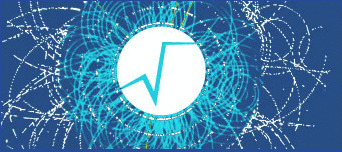 |
ROOT 6.13/01 Reference Guide |
 |
ROOT 6.13/01 Reference Guide |
GenVector, is a new package intended to prepresent vectors and their operations and transformations, such as rotations and Lorentz transformations, in 2, 3 and 4 dimensions. The 2D and 3D space are used to describe the geometry vectors and points, while the 4D space-time is used for physics vectors representing relativistic particles. These 2D,3D and 4D vectors are different from vectors of the Linear Algebra package which describe generic N-dimensional vectors. Similar functionality is currently provided by the CLHEP Vector and Geometry packages and the ROOT Physics Vector classes (Tvector2, TVector3 and TLorentzVector). It is also re-uses concepts and ideas from the CMS Common Vector package.
In contrast to CLHEP or the ROOT physics libraries, GenVector provides class templates for modelling the vectors. There is a user-controlled freedom on how the vector is internally represented. This is expressed by a choice of coordinate system which is supplied as a template prameter when the vector is constructed. Furthermore each coordinate system is itself a template, so that the user can specify the underlying scalar type. In more detail, the main characteristics of GenVector are:
Optimal runtime performances
We try to minimize any overhead in the run-time performances. We have deliberatly avoided to have any virtual function and even virtual destructors in the classes and have inlined as much as possible all the functions. For this reason, we have chosen to use template classes to implement the GenVector concepts instead of abstract or base classes and virtual functions.
Points and Vector concept
Mathematically vectors and points are two distinct concepts. They have different transformations, like vectors only rotate while points rotate and translate. You can add two vectors but not two points and the difference between two points is a vector. We then distinguish for the 2 and 3 dimensional case, between points and vectors, modeling them with different classes:
Generic Coordinate System
The vector classes are based on a generic type of coordinate system, expressed as a template parameter of the class. Various classes exist to describe the various coordinates systems:
Coordinate System Tag
The 2D and 3D points and vector classes can be associated to a tag defining the coordinate system. This can be used to distinguish between vectors of different coordinate systems like global or local vectors. The coordinate system tag is a template parameter of the ROOT::Math::DisplacementVector3D (and ROOT::Math::DisplacementVector2D) and ROOT::Math::PositionVector3D (and ROOT::Math::PositionVector2D) classes. A default tag, ROOT::Math::DefaultCoordinateSystemTag, exists for users who don't need this functionality.
Transformations
The transformations are modeled using simple (non-template) classes, using double as the scalar type to avoid too large numerical errors. The transformations are grouped in Rotations (in 3 dimensions), Lorentz transformations and Poincarre transformations, which are Translation/Rotation combinations. Each group has several members which may model physically equivalent trasformations but with different internal representations. Transformation classes can operate on all type of vectors using the operator() or the operator * and the transformations can also be combined via the operator *. In more detail the transformations available are:
3D Transformation
We describe the transformations defined as a composition between a rotation and a translation using the class ROOT::Math::Transform3D. It is important to note that transformations act differently on Vectors and Points. The Vectors only rotate, therefore when applying a transfomation (rotation + translation) on a Vector, only the rotation operates while the translation has no effect. The interface for Transformations is similar to the one used in the CLHEP Geometry package (class Transform3D). A class, ROOT::Math::Translation3D. describe transformations consisting of only a translation. Translation can be applied only on Points, applying them on Vector objects has no effect. The Translation3D class can be combined with both ROOT::Math::Rotation3D and ROOT::Math::Transform3D using the operator * to obtain a new transformation as an instance of a Transform3D class.
Other main characteristics of the GenVector classes are:
Minimal Vector classes interface
We have tried to keep the interface to a minimal level:
Naming Convention
As part of ROOT, the GenVector package adheres to the prescribed ROOT naming convention, with some (approved) exceptions, as described here:
Connection to Linear Algebra package
In some use cases, like in track reconstruction, it is needed to use the content of the vector and rotation classes in conjunction with linear algebra operations. We prefer to avoid any direct dependency to any Linear algebra package. However, we provide some hooks to convert to and from Linear Algebra classes.
This GenVector package is part of the ROOT Reference Documentation and it can be built as an independent package. A tar file can be downloaded from here.
A more detailed description of all the GenVector classes is available in this document.
*/